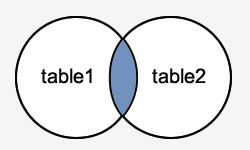SQL Server: EXCEPT Operator
This SQL Server tutorial explains how to use the EXCEPT operator in SQL Server (Transact-SQL) with syntax and examples.
Description
The SQL Server (Transact-SQL) EXCEPT operator is used to return all rows in the first SELECT statement that are not returned by the second SELECT statement. Each SELECT statement will define a dataset. The EXCEPT operator will retrieve all records from the first dataset and then remove from the results all records from the second dataset.
Except Query
Explanation: The EXCEPT query will return the records in the blue shaded area. These are the records that exist in Dataset1 and not in Dataset2.
Each SELECT statement within the EXCEPT query must have the same number of fields in the result sets with similar data types.
Syntax
The syntax for the EXCEPT operator in SQL Server (Transact-SQL) is:
SELECT expression1, expression2, ... expression_n FROM tables [WHERE conditions] EXCEPT SELECT expression1, expression2, ... expression_n FROM tables [WHERE conditions];
Parameters or Arguments
- expressions
- The columns or calculations that you wish to compare between the two SELECT statements. They do not have to be the same fields in each of the SELECT statements, but the corresponding columns must be similar data types.
- tables
- The tables that you wish to retrieve records from. There must be at least one table listed in the FROM clause.
- WHERE conditions
- Optional. The conditions that must be met for the records to be selected.
Note
- There must be same number of expressions in both SELECT statements.
- The corresponding columns in each of the SELECT statements must have similar data types.
- The EXCEPT operator returns all records from the first SELECT statement that are not in the second SELECT statement.
- The EXCEPT operator in SQL Server is equivalent to the MINUS operator in Oracle.
Example - With Single Expression
Let's look at an example of the EXCEPT operator in SQL Server (Transact-SQL) that returns one field with the same data type.
For example:
SELECT product_id FROM products EXCEPT SELECT product_id FROM inventory;
This EXCEPT operator example returns all product_id values that are in the products table and not in the inventory table. What this means is that if a product_id value existed in the products table and also existed in the inventory table, the product_id value would not appear in the EXCEPT query results.
Example - With Multiple Expressions
Next, let's look at an example of an EXCEPT query in SQL Server (Transact-SQL) that returns more than one column.
For example:
SELECT contact_id, last_name, first_name FROM contacts WHERE last_name = 'Anderson' EXCEPT SELECT employee_id, last_name, first_name FROM employees;
In this EXCEPT example, the query will return the records in the contacts table with a contact_id, last_name, and first_name value that does not match the employee_id, last_name, and first_name value in the employees table.
Example - Using ORDER BY
Finally, let's look at how to use the ORDER BY clause in an EXCEPT query in SQL Server (Transact-SQL).
For example:
SELECT supplier_id, supplier_name FROM suppliers WHERE state = 'Florida' EXCEPT SELECT company_id, company_name FROM companies WHERE company_id <= 400 ORDER BY 2;
In this EXCEPT example, since the column names are different between the two SELECT statements, it is more advantageous to reference the columns in the ORDER BY clause by their position in the result set. In this example, we've sorted the results by supplier_name / company_name in ascending order, as denoted by the ORDER BY 2.
The supplier_name / company_name fields are in position #2 in the result set.


No comments:
Post a Comment